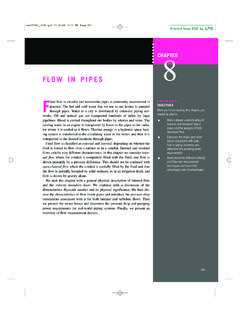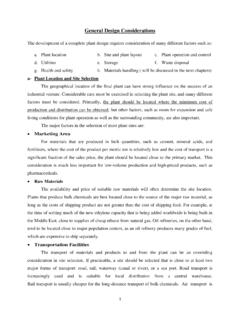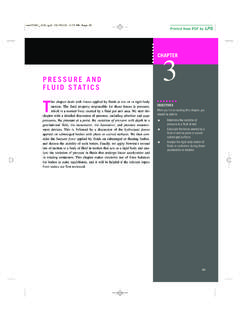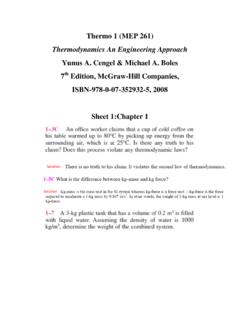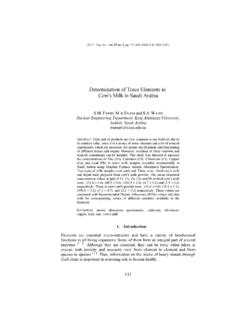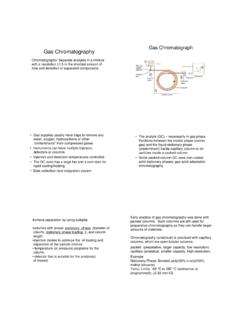Transcription of Biochemistry and Molecular Biology - kau.edu.sa
1 Principles and Techniques of Biochemistry and Molecular Biology Seventh edition EDITED BY KEITH WILSON AND JOHN WALKER. This new edition of the bestselling textbook integrates the theoretical principles and experimental techniques common to all undergraduate courses in the bio- and medical sciences. Three of the 16 chapters have new authors and have been totally rewritten. The others have been updated and extended to re ect developments in their eld exempli ed by a new section on stem cells. Two new chapters have been added.
2 One on clinical Biochemistry discusses the principles underlying the diagnosis and management of common biochemical disorders. The second one on drug discovery and development illustrates how the principles and techniques covered in the book are fundamental to the design and development of new drugs. In-text worked examples are again used to enhance student understanding of each topic and case studies are selectively used to illustrate important examples. Experimental design, quality assurance and the statistical analysis of quantitative data are emphasised throughout the book.
3 Motivates students by including cutting-edge topics and techniques, such as drug discovery, as well as the methods they will encounter in their own lab classes Promotes problem solving by setting students a challenge and then guiding them through the solution Integrates theory and practise to ensure students understand why and how each technique is used. K E I T H W I L S O N is Professor Emeritus of Pharmacological Biochemistry and former Head of the Department of Biosciences, Dean of the Faculty of Natural Sciences, and Director of Research at the University of Hertfordshire.
4 J O H N W A L K E R is Professor Emeritus and former Head of the School of Life Sciences at the University of Hertfordshire. Cover illustration Main image Electrophoresis gel showing recombinant protein. Photographer: Revy. Courtesy of Science Photo Library. Top inset Transcription factor and DNA molecule. Courtesy of: Laguna Design/Science Photo Library. Second inset Microtubes, pipettor (pipette) tip & DNA sequence. Courtesy of Tek Image/Science Photo Library. Third inset Stem cell culture, light micrograph.
5 Photographer: Philippe Plailly. Courtesy of Science Photo Library. Fourth inset Embryonic stem cells. Courtesy of Science Photo Library. Bottom inset Herceptin breast cancer drug, Molecular model. Photographer: Tim Evans. Courtesy of Science Photo Library. Principles and Techniques of Biochemistry and Molecular Biology Seventh edition Edited by KEITH WILSON AND JOHN WALKER. CAMBRIDGE UNIVERSITY PRESS. Cambridge, New York, Melbourne, Madrid, Cape Town, Singapore, Sa o Paulo, Delhi, Dubai, Tokyo Cambridge University Press The Edinburgh Building, Cambridge CB2 8RU, UK.
6 Published in the United States of America by Cambridge University Press, New York Information on this title: First and second editions # Bryan Williams and Keith Wilson 1975, 1981. Third edition # Keith Wilson and Kenneth H. Goulding 1986. Fourth edition # Cambridge University Press 1993. Fifth edition # Cambridge University Press 2000. Sixth edition # Cambridge University Press 2005. Seventh edition # Cambridge University Press 2010. This publication is in copyright. Subject to statutory exception and to the provisions of relevant collective licensing agreements, no reproduction of any part may take place without the written permission of Cambridge University Press.
7 First published by Edward Arnold 1975 as A Biologist's Guide to Principles and Techniques of Practical Biochemistry Second edition 1981; Third edition 1986. Third edition first published by Cambridge University Press 1992; Reprinted 1993. Fourth edition published by Cambridge University Press 1994 as Principles and Techniques of Practical Biochemistry ; Reprinted 1995, 1997; Fifth edition 2000. Sixth edition first published by Cambridge University Press 2005 as Principles and Techniques of Biochemistry and Molecular Biology ; Reprinted 2006, 2007.
8 Seventh edition first published by Cambridge University Press 2010. Printed in the United Kingdom at the University Press, Cambridge A catalogue record for this publication is available from the British Library Library of Congress Cataloging-in-Publication Data Principles and techniques of Biochemistry and Molecular Biology / edited by Keith Wilson, John Walker. 7th ed. p. cm. ISBN 978-0-521-51635-8 (hardback) ISBN 978-0-521-73167-6 (pbk.). 1. Biochemistry Textbooks. 2. Molecular Biology Textbooks. I. Wilson, Keith, 1936 II.
9 Walker, John M., 1948 III. Title. 2009. 6120 .015 dc22 2009043277. ISBN 978-0-521-51635-8 Hardback ISBN 978-0-521-73167-6 Paperback Cambridge University Press has no responsibility for the persistence or accuracy of URLs for external or third-party internet websites referred to in this publication, and does not guarantee that any content on such websites is, or will remain, accurate or appropriate. CONTENTS. Preface to the seventh edition page xi List of contributors xiii List of abbreviations xv 1 Basic principles 1.
10 K. WILSON. Biochemical and Molecular Biology studies 1. Units of measurement 3. Weak electrolytes 6. Quantitative biochemical measurements 16. Safety in the laboratory 35. Suggestions for further reading 37. 2 Cell culture techniques 38. A. R. BAYDOUN. Introduction 38. The cell culture laboratory and equipment 39. Safety considerations in cell culture 43. Aseptic techniques and good cell culture practice 44. Types of animal cell, characteristics and maintenance in culture 49. Stem cell culture 61. Bacterial cell culture 68.
